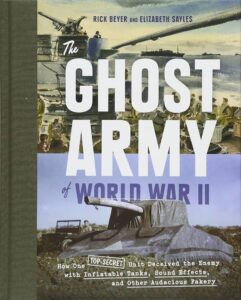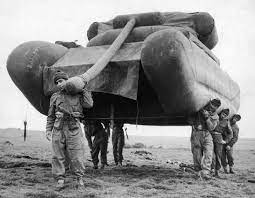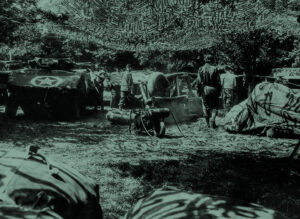In the midst of chaos and destruction during World War II, a remarkable unit of artists, designers, and creatives—known as the Ghost Army—quietly embarked on a mission unlike any other. This secret group used ingenious tactics, including inflatable tanks and artificial sound effects, to deceive the enemy and manipulate the tides of war. This article delves into the enthralling story of the Ghost Army, shedding light on their remarkable contributions and their vital role in military deception.



The Origins of the Ghost Army:
As World War II raged on, military strategists realized the importance of deception on the battlefield. In response to this need, the Ghost Army was born. Officially known as the 23rd Headquarters Special Troops, this unique unit was composed of soldiers with creative backgrounds, such as painters, designers, sound engineers, and even Hollywood set artists.
The Deceptive Repertoire:
The Ghost Army’s arsenal of deception techniques was truly extraordinary. One of their most audacious tactics was the use of inflatable tanks, trucks, and artillery. These lightweight and easily transportable decoys convincingly imitated real military vehicles. When deployed, they created the illusion of large-scale troop movements, misleading enemy reconnaissance planes and operatives.
Beyond visual deception, the Ghost Army employed audio trickery as well. They utilized massive speakers mounted on vehicles, known as “sonic trucks,” which simulated the sounds of armored divisions on the move. These convincing sound effects masked the absence of actual troops, further misleading the enemy.
Creating Illusions:
To enhance the illusion of military strength, Ghost Army soldiers transformed themselves into different roles. Donning the uniforms of higher ranking officers, they strategically positioned themselves in visible areas, giving the impression of a significant military presence. This elaborate charade aimed to divert enemies’ attention from actual troop movements and strategic objectives.
Operational Success and Secrecy:
The Ghost Army’s activities were mostly classified until many years after World War II. Nonetheless, they played an instrumental role in numerous operations throughout the conflict. The unit deployed their tactics across Europe, undertaking mock offensives, and establishing decoy establishments. Their actions kept the enemy guessing and gained their comrades crucial advantages.
Legacy and Recognition:
Despite their invaluable contributions, the Ghost Army’s efforts remained largely unknown until the 1990s, when the U.S. Army declassified their mission. The recognition that followed shed light on their ingenious tactics and their immense impact on the outcome of the war. In 2015, the Ghost Army was awarded the Congressional Gold Medal, the highest civilian honor in the United States, marking the official acknowledgment of their remarkable accomplishments.
Conclusion:
The Ghost Army’s story stands as a testament to the remarkable power of creativity and innovation, even in the darkest times of war. Their unconventional tactics and ingenuity not only influenced the outcome of critical battles but also revolutionized the field of military deception. The Ghost Army’s legacy serves as a reminder that ideas brought to life by talented individuals can truly change the course of history. Their story deserves to be celebrated as a testament to human adaptability and the power of art in the face of adversity.

